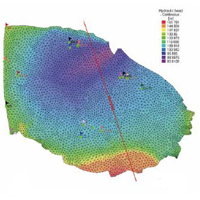Multi-Technique groundwater flow system analysis and dating of deep aquifers in Alessandria Basin (Piedmont - IT)

Published: 30 March 2020
Abstract Views: 890
PDF: 781
Publisher's note
All claims expressed in this article are solely those of the authors and do not necessarily represent those of their affiliated organizations, or those of the publisher, the editors and the reviewers. Any product that may be evaluated in this article or claim that may be made by its manufacturer is not guaranteed or endorsed by the publisher.
All claims expressed in this article are solely those of the authors and do not necessarily represent those of their affiliated organizations, or those of the publisher, the editors and the reviewers. Any product that may be evaluated in this article or claim that may be made by its manufacturer is not guaranteed or endorsed by the publisher.
Similar Articles
- Gioia Bravini, Matia Menichini, Marco Doveri, Numerical modelling in the coastal aquifer between Burlamacca Canal and Bufalina Ditch, southern Versilia (Tuscany, Italy) , Acque Sotterranee - Italian Journal of Groundwater: Vol. 4 No. 1 (2015)
- Filiz Dadaser-Celik, Mete Celik, Modelling surface water-groundwater interactions at the Palas Basin (Turkey) using FREEWAT , Acque Sotterranee - Italian Journal of Groundwater: Vol. 6 No. 3 (2017)
- Ourdia Kaben, Djamel Maizi, Mebarka Takorabt, Sequential direct and inverse modeling of underground flows in the Upper Cheliff Alluvial Aquifer, Algeria , Acque Sotterranee - Italian Journal of Groundwater: Vol. 12 No. 4 (2023)
- Giovanni Pietro Beretta, Monica Avanzini, Tomaso Marangoni, Marino Burini, Giacomo Schirò, Jacopo Terrenghi, Gaetano Vacca, Groundwater modeling of the withdrawal sustainability of Cannara artesian aquifer (Umbria, Italy) , Acque Sotterranee - Italian Journal of Groundwater: Vol. 7 No. 3 (2018)
- Giovanni Conte, Pio Di Manna, Rossella Maria Gafà, Lucio Martarelli, Gennaro Maria Monti, Marco Amanti, Sustainable yield of the Colle Quartara carbonate aquifer in the Southern Lepini Mountains (Central Italy) , Acque Sotterranee - Italian Journal of Groundwater: Vol. 5 No. 3 (2016)
- Giuseppe Sappa, Flavia Ferranti, Francesco Maria De Filippi, A proposal of conceptual model for Pertuso Spring discharge evaluation in the Upper Valley of Aniene River , Acque Sotterranee - Italian Journal of Groundwater: Vol. 5 No. 3 (2016)
- Riccardo Armellini, Elena Baldini, Dario Del Seppia, Fabrizio Franceschini, Natacha Gori, Stefano Menichetti, Stefano Tessitore, Groundwater Flow and Transport Model in Cecina Plain (Tuscany, Italy) using GIS processing , Acque Sotterranee - Italian Journal of Groundwater: Vol. 4 No. 1 (2015)
- Leonardo Piccinini, Valentina Vincenzi, Alessandro Pontin, Federico Tonet, Heat transport modeling for the design of a low enthalpy open-loop system , Acque Sotterranee - Italian Journal of Groundwater: Vol. 1 No. 3 (2012)
- Ezio Crestaz, Michele Pellegrini, Peter Schätzl, Tight-coupling of groundwater flow and transport modelling engines with spatial databases and GIS technology: a new approach integrating Feflow and ArcGIS , Acque Sotterranee - Italian Journal of Groundwater: Vol. 1 No. 2 (2012)
- Andrea Gigliuto, Chiara Righetti, Roberta Vaccari, Leandro Moretti, Field and modeling studies of aquifer heterogeneity to improve remediation planning in a multilayered aquifer system , Acque Sotterranee - Italian Journal of Groundwater: Vol. 1 No. 2 (2012)
1-10 of 327
Next
You may also start an advanced similarity search for this article.








